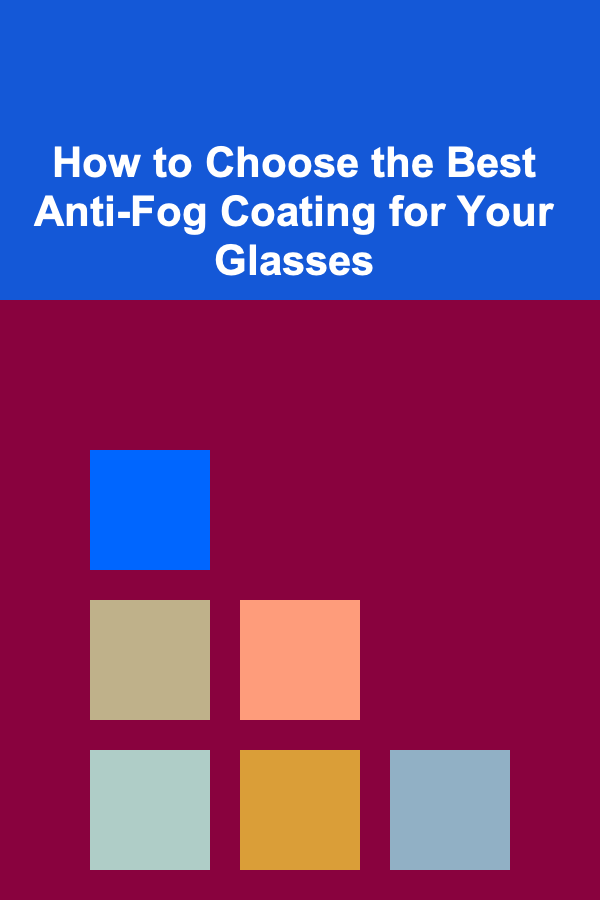
How to Choose the Best Anti-Fog Coating for Your Glasses
ebook include PDF & Audio bundle (Micro Guide)
$12.99$7.99
Limited Time Offer! Order within the next:

When it comes to wearing glasses, one of the most frustrating problems that individuals face is fogging. Whether you're moving between warm and cold environments, exercising, or wearing a mask, the lenses of your glasses can fog up, causing temporary vision impairment and inconvenience. Anti-fog coatings have emerged as an effective solution to this issue, but with so many options available, it can be difficult to determine which one is best suited for your needs.
This comprehensive guide will explore the various types of anti-fog coatings available for glasses, their benefits, how to choose the right one for your specific needs, and some tips for maintaining clear lenses over time. By the end of this article, you'll be equipped with all the knowledge you need to make an informed decision and keep your glasses clear and fog-free.
What is an Anti-Fog Coating?
An anti-fog coating is a thin layer applied to the surface of your glasses lenses to prevent moisture condensation, which leads to fogging. This coating works by creating a hydrophilic (water-attracting) surface that prevents the buildup of water droplets on the lens. Instead of forming droplets, the moisture spreads evenly across the surface, which makes it invisible to the eye and maintains clear vision.
There are various types of anti-fog treatments available, and the effectiveness of these coatings can vary based on the type of coating and how it's applied. Let's take a closer look at the different options.
Types of Anti-Fog Coatings
1. Permanent Anti-Fog Coatings
Permanent anti-fog coatings are applied directly to the lenses during manufacturing, providing long-lasting protection against fogging. These coatings are built into the lens and are designed to be durable and effective over time.
Advantages:
- Long-lasting: As the name suggests, permanent coatings do not wear off easily, meaning you don't have to worry about reapplying the coating frequently.
- Durability: These coatings are highly resistant to scratches, smudges, and other types of damage.
- No need for maintenance: Once applied, permanent coatings offer consistent protection without the need for ongoing maintenance.
Disadvantages:
- Initial cost: Permanent anti-fog coatings can be more expensive compared to lenses without coatings or lenses that only have a temporary anti-fog treatment.
- Limited options for customization: You might not have the option to choose the specific brand or technology used to apply the anti-fog coating, especially if it's part of a package when purchasing new lenses.
Best For:
People who wear glasses frequently and want a long-term solution to fogging without having to worry about reapplication. Also ideal for those who want minimal maintenance for their lenses.
2. Temporary Anti-Fog Sprays
Temporary anti-fog sprays are easy-to-apply solutions that can be sprayed onto the surface of your lenses. These sprays work similarly to permanent coatings by spreading moisture across the lens surface, preventing the formation of water droplets.
Advantages:
- Cost-effective: Temporary sprays are generally more affordable than permanent coatings or specialized lenses.
- Easy to apply: You can apply the spray to your lenses whenever needed, and the process is straightforward.
- Reapplication flexibility: If you don't need the coating for long periods, you can apply it as needed, depending on your activities.
Disadvantages:
- Frequent reapplication: Temporary anti-fog sprays lose their effectiveness over time, especially if the lenses are cleaned or exposed to moisture. Therefore, you'll need to reapply the spray regularly.
- Potential residue: Some sprays leave a residue or film on the lens that can affect visibility, requiring extra cleaning.
Best For:
People who want an affordable and flexible solution to anti-fogging, especially for specific activities like sports, working out, or wearing masks during short-term situations.
3. Anti-Fog Wipes
Anti-fog wipes are pre-moistened disposable cloths that are designed to clear fog from your lenses. These wipes often contain an anti-fog solution that prevents the buildup of condensation.
Advantages:
- Convenient: Anti-fog wipes are small and portable, making them perfect for on-the-go use.
- Effective in the short term: They provide instant fog prevention and clear vision quickly.
- Easy to use: Simply wipe the lens with the cloth, and the anti-fog solution works immediately.
Disadvantages:
- Not long-lasting: The effect of anti-fog wipes is temporary, and the fog may return after a few hours or a few uses.
- Single-use: Many anti-fog wipes are designed for single-use, which can be wasteful over time and might incur additional costs.
Best For:
Individuals who need a quick fix for fogging, such as when entering a warm building from the cold or after exercising. Anti-fog wipes are also great for people who travel frequently and need a portable solution.
4. Anti-Fog Lens Cloths
These cloths are often treated with an anti-fog solution and can be used to wipe down lenses to prevent fogging. Unlike wipes, these cloths are reusable and designed for longer-term use.
Advantages:
- Reusable: Since these cloths are washable, you can use them repeatedly without worrying about running out or throwing them away.
- Environmentally friendly: By reusing the cloth, you reduce waste compared to disposable wipes.
- Cost-effective: While the initial cost of a treated cloth might be higher than disposable wipes, the ability to reuse it makes it more economical in the long run.
Disadvantages:
- Limited longevity: Over time, the anti-fog solution on the cloth can wear off, requiring you to reapply the solution manually.
- Requires regular washing: To maintain the effectiveness of the cloth, you need to wash it frequently to keep it free from oils and dirt that may reduce its performance.
Best For:
People who prefer a reusable solution and are looking for something practical for daily use, such as commuters or those who wear glasses regularly in environments where fogging is common.
5. Hydrophobic and Oleophobic Coatings
In addition to anti-fog coatings, some lenses come with hydrophobic (water-repelling) and oleophobic (oil-repelling) coatings. These coatings are designed to reduce the buildup of water droplets and oils, which can contribute to fogging.
Advantages:
- Water and oil resistance: Hydrophobic and oleophobic coatings prevent moisture and oils from sticking to the lens, which reduces the likelihood of fog formation.
- Clearer vision: The coatings help keep the lenses cleaner for longer periods, maintaining clear vision.
- Durable: These coatings can last a significant amount of time, especially if the lenses are well cared for.
Disadvantages:
- Cost: Hydrophobic and oleophobic coatings may increase the overall price of your lenses.
- Possible wear over time: Like other coatings, these can wear off over time, especially if the lenses are frequently cleaned or exposed to abrasive conditions.
Best For:
People who are looking for lenses that resist fogging as well as smudges, water droplets, and oils, which can improve overall clarity. Ideal for those who wear glasses in challenging environments, such as while exercising or working in humid conditions.
How to Choose the Best Anti-Fog Coating for Your Glasses
Choosing the best anti-fog coating for your glasses depends on several factors, including your lifestyle, budget, and how often you encounter fogging. To make an informed decision, consider the following criteria:
1. How Often You Experience Fogging
If you frequently experience fogging, investing in permanent anti-fog coatings or lenses with built-in treatments is a good long-term solution. These options offer durable, hassle-free fog protection, ideal for everyday use.
If you only occasionally encounter fogging---such as during exercise or when wearing a mask---temporary solutions like anti-fog sprays or wipes might be more suitable.
2. Your Budget
Permanent coatings and specialized lenses often come with a higher price tag, while temporary solutions like sprays and wipes are more affordable. If you are on a budget, consider starting with a temporary anti-fog solution before committing to more expensive options.
3. Environmental Factors
Consider where and when you experience the most fogging. If you're frequently in environments with fluctuating temperatures, high humidity, or during physical activities, you might want a more robust and long-lasting solution, such as permanent coatings or hydrophobic coatings. For occasional fogging, wipes or sprays may suffice.
4. Maintenance Preferences
If you prefer a low-maintenance solution that doesn't require frequent reapplication, permanent anti-fog coatings or hydrophobic coatings are the best choices. If you don't mind reapplying coatings or wiping your lenses down, then wipes, sprays, or reusable cloths can be more convenient.
Tips for Maintaining Your Anti-Fog Coating
To maximize the effectiveness of your anti-fog coating, follow these simple maintenance tips:
- Avoid abrasive cleaning: Use microfiber cloths and gentle cleaning solutions to avoid damaging the coating.
- Store your glasses properly: Keep your glasses in a protective case when not in use to prevent scratches and damage to the coating.
- Reapply when necessary: If using a temporary anti-fog solution, make sure to reapply as needed for optimal results.
Conclusion
Choosing the best anti-fog coating for your glasses requires considering your personal preferences, lifestyle, and the degree of fogging you experience. Permanent coatings provide long-lasting protection, while temporary solutions offer flexibility and affordability. By understanding the different types of anti-fog coatings and their benefits, you can make an informed decision that keeps your glasses clear and your vision sharp, no matter the conditions.
Reading More From Our Other Websites
- [Home Pet Care 101] How to Maintain Your Pet's Toys and Accessories
- [Organization Tip 101] Smart Faucets vs. Traditional Faucets: Which One Is Right for You?
- [Home Party Planning 101] How to Create a Relaxing Atmosphere for a Dinner Party
- [Home Staging 101] How to Stage Your Home for Luxury Buyers
- [Home Maintenance 101] How to Clean and Maintain Your Garbage Disposal
- [Home Budget Decorating 101] How to Style Your Bookshelves Affordably
- [Home Security 101] How to Decide Between DIY and Professional Home Security Installation
- [Home Budget 101] How to Save for a Down Payment on a New Home
- [Personal Care Tips 101] How to Choose Hair Gel for Soft, Touchable Styles
- [Personal Care Tips 101] How to Apply Mascara for an Elegant Evening Look

How to Balance Your Full-Time Job with Teaching Music Lessons Part-Time
Read More
How to Identify and Treat Common Pet Health Problems at Home
Read More
How to Make Your Home Pet-Friendly Without Sacrificing Style
Read More
How to Offer Remote IT Support Services
Read More
How to Store Stickers and Stamps for Easy Access
Read More
10 Tips for Using a Theme-Based Planner to Spark Creative Writing Ideas
Read MoreOther Products

How to Balance Your Full-Time Job with Teaching Music Lessons Part-Time
Read More
How to Identify and Treat Common Pet Health Problems at Home
Read More
How to Make Your Home Pet-Friendly Without Sacrificing Style
Read More
How to Offer Remote IT Support Services
Read More
How to Store Stickers and Stamps for Easy Access
Read More